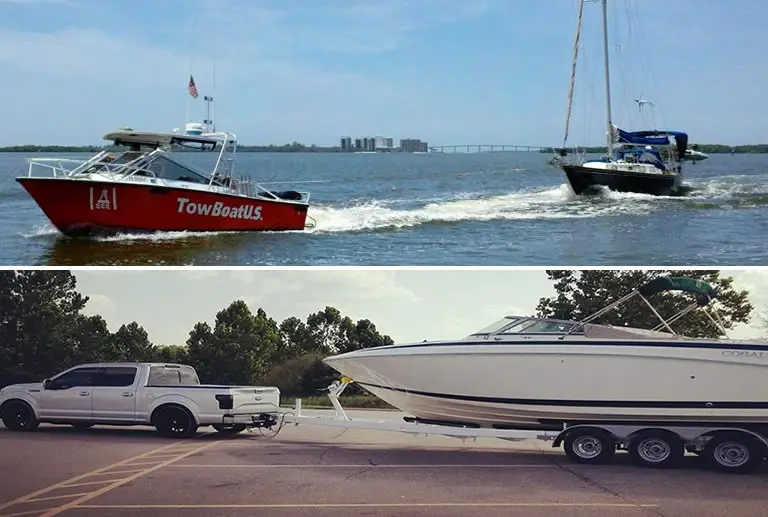Contents
- Guide To Boat Towing On Water & Towing A Boat With A Car
- What You Need For Towing A Boat On Land And Water
- How To Tow A Boat With A Car – 6 Initial Steps
- 1. Check your vehicle pulling load
- 2. You must know the important specs of your boat trailer
- i) Check the load capacity of the trailer
- ii) Be aware of the legal weight restrictions for your state
- iii) Width load must be overserved
- iv) The length of the trailer is important
- v) Be sure the trailer is fitted with the correct tires
- vi) Some states require the trailer to be fitted with its own brakes
- vii) Tail, brake and signal lights are a legal requirement across the US
- viii) Vehicles towing trailered boats are subject speed limits
- 3. There are also some Federal driver legal requirements for towing
- 4. Always carry out safety checks before embarking
- 5. Secure the boat to the trailer
- 6. Attach the trailer to your vehicle
- Getting Underway – Guide To Towing A Boat With A Car Safely
- Instructions For On Water Towing
- Getting Underway. Boat Towing Water Guide
Guide To Boat Towing On Water & Towing A Boat With A Car
Moving a boat usually just requires starting up the engine and pointing the boat in the right direction.
A simplified explanation of boating but basically true.
Sometimes though this is just not an option when you need to get your boat from point A on land to point B in the water.
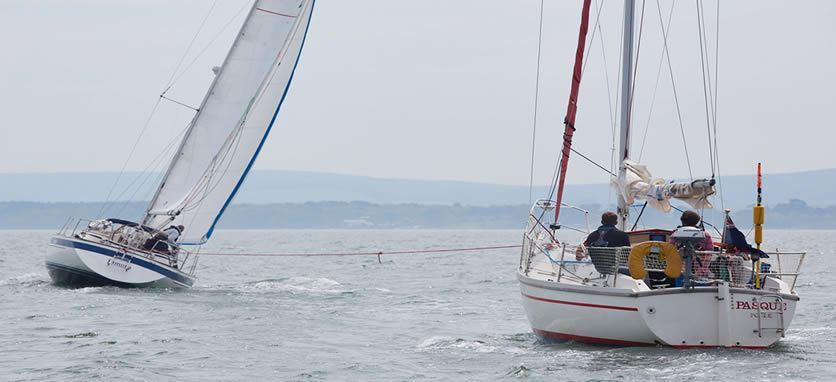
Or, when your boat is at the mercy of the currents because its engines have given-up.
So, there may be times when your boat needs towed over land by a road vehicle and times when it needs a tow on the water from another boat.
Therefore when it comes to transporting a boat there are two different types of towing involved.
They are:
- Towing the boat on land.
- Towing the boat on the water.
Obviously these involve different steps, techniques and equipment.
In this guide we will cover both types of towing so you have a thorough knowledge of how to move your boat no matter where it is and in what condition it is in.
Below we cover both how to tow a boat on land and how to tow a boat on the water.
If you also need to learn how to load and unload a boat onto a trailer be sure to read our guide on that.
What You Need For Towing A Boat On Land And Water
Before we begin be sure you have the correct equipment.
What you need to tow a boat on land
To two a boat on land you will need:
- An appropriate sized boat trailer.
- The boat trailer should have specs that conform to your state laws. (see below)
- A vehicle with a hitch.
- Heavy duty ratchet straps, or tie down straps, to secure the boat safely.
What you need for on water towing
To two a boat on water you will need:
A boat rope.
Cleats on the boat to secure the rope.
A knowledge of how to tie a towing bridle. (see video below)
How To Tow A Boat With A Car – 6 Initial Steps
Towing a boat over land requires preparation and research on your part.
Why?
Because you are required by law to take certain specific steps to ensure your safety and the safety of other road users.
There are legal requirements you must adhere to and there are suggested requirements you should adhere to for the protection of your boat and road vehicle.
You need to know the weight of your boat and your trailer as well as the load capacity of your trailer and the pulling capacity of your towing vehicle.
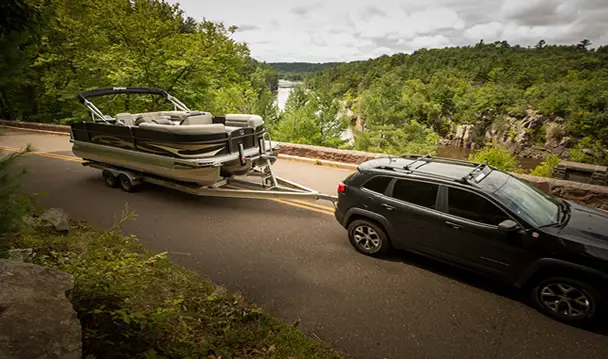
Getting the numbers wrong when it comes to weight and towing capacity can be disastrous for your towing vehicle, your trailer and your boat.
Let’s look at these requirements for land towing in more detail as they relate to your vehicle, trailer and boat.
1. Check your vehicle pulling load
You need to start by finding out the pulling capacity of your road vehicle before you attempt to tow your boat.
Manufacturers of road vehicles will specify a permissible maximum trailer weight.
Be aware that this number is based on the road vehicle carrying only the driver and a full tank of fuel.
If you have a vehicle filled with family members and/or gear the maximum trailer weight should be lowered.
If a Gross Combined Vehicle Weight (called Gross Train Weight in the UK) is given in the owner’s manual or online then the overall weight of the car plus the trailer combined should not be exceeded.
Your vehicle owner’s manual will have a chart indicating the maximum trailer weight and the Gross Combined Vehicle Weight (GCVW).
Remember the maximum trailer weight of your towing vehicle must not be lower than the weight of your boat & its equipment combined with the weight of the trailer!
If you do not know your vehicle’s towing capacity, look at the owner’s manual, search for it online or contact the manufacturer or an officially recognized local dealer.
Unfortunately, it can be difficult to the get numbers exactly right because there are so many variables involved.
Generic weights are often given for boats by manufacturers. It can therefore be difficult to determine the exact weight of all the different accessories and additional fittings you have on your boat.
A close approximation of the load will usually be enough.
However, if you find that your approximation is dangerously close to the maximum that your towing vehicle can handle you will have to do a bit more research.
If you don’t, you run the risk of damaging your road vehicle by forcing it to haul beyond its capacity.
If you haul beyond your vehicle’s capacity you also run the risk of damaging your trailer and boat, and causing a road accident, if the trailer beaks free while traveling.
As a safety precaution many boat owners will not exceed 80% of the road vehicle’s maximum towing weight.
The best way to know the exact and precise weight of your trailer is to take it to a scale at a truck stop.
You can also weigh the trailer and boat together.
After you know the boat trailer weight, you can check the VIN sticker on the trailer to make sure that trailer and its tires are rated to carry the load you’ve got on it.
If you want to determine the Gross Combined Vehicle Weight of the boat, tow vehicle, passengers and gear, park the entire rig on the scale.
2. You must know the important specs of your boat trailer
There are a number of other requirements that a boat trailer must meet.
Let’s take a look at those now.
i) Check the load capacity of the trailer
You need to know the weight capacity of your trailer before you load a boat on it.
It is likely you purchased a trailer with your boat so it will have the right specs if you bought it from a reputable dealer.
If you usually keep your boat on the water, or plan to acquire a new boat trailer, be sure to check its load capacity against the weight of your boat. Also include the weight of everything extra that is kept on and in the boat.
As suggested above you can weigh your trailer easily at a truck stop.
However, knowing the load capacity is not the only thing you should know about your trailer.
ii) Be aware of the legal weight restrictions for your state
The weight of the boat and trailer is also considered in some US towing regulations.
Most manufacturers are careful to provide a trailer with plenty of capacity for recommended boat sizes, but if you are carrying a lot of gear you could be cutting it close.
If you intend to buy a used boat then you will want to check the trailer capacity before buying it.
Don’t just take the seller’s word for it!
iii) Width load must be overserved
In most states a trailer that is 8′ 6″ and above in width is considered a wide load.
This means the use of your trailer may be subject to certain restrictions and depending on the state you live, or travel in, it may even require a permit to be used on the roads.
In some states there are laws indicating days and times when a wide load cannot be taken on the road, so be sure to research before heading out on the highway.
iv) The length of the trailer is important
Maximum allowed trailer length varies depending on the state you are traveling in.
State laws also consider the combined length of your tow vehicle and your trailer.
If the combined length is over 85 feet you will most likely need an over-size load permit and will be subject to traveling under some restrictions.
v) Be sure the trailer is fitted with the correct tires
Be sure the tires on your trailer are adequate for the load you intend to put on them.
Also, make sure they have sufficient thread for good road holding and are in overall good condition.
vi) Some states require the trailer to be fitted with its own brakes
Laws regarding the fitting of brakes on trailers differ from state to state.
The most common law you will encounter in the majority of states requires that any trailer which weighs more than 3,000 pounds must be fitted with its own brakes.
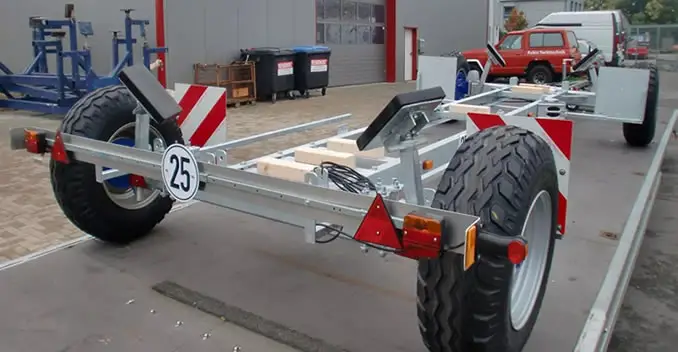
There are some states that have absolutely no laws regarding trailer brakes while other states require brakes to be fitted on all trailers regardless of size and weight.
Also be aware that state laws differ regarding brakes on trailer axles.
Research the states you plan to travel in and be sure your trailer abides by those local brake laws.
vii) Tail, brake and signal lights are a legal requirement across the US
US manufacturers, and foreign manufactures who export to the USA, ensure all trailers are equipped with the legally-required lights, as per the Federal Department of Transportation regulations.
It is your responsibility though to ensure that the lights are functional and working correctly.
Always check the tail, brake and blinkers on your trailer are working before each trip.
viii) Vehicles towing trailered boats are subject speed limits
Speed limits usually apply to trailer-carrying vehicles in most states.
Even if the state you are travelling in does not have any speed limit law you should take it slow anyway!
Traveling at slower speeds with a trailer attached to your vehicle means you have more time to react to adverse road conditions.
Slower speeds allow you to stop over a shorter distance as well.
Traveling at slower speeds with a heavy load can also improve your fuel economy.
3. There are also some Federal driver legal requirements for towing
Federal law requires drivers to hold a commercial license before towing more than 26,000 pounds.
Most private boat trailers weight between 300lbs and 1,512lbs . A motor boat averages out at about 2,500lbs. So even a large sailboat will weigh no more than about 8,000lbs you don’t have much to worry about as far as legal towing requirements go.
Your normal driving license should be enough to allow you to tow your boat.
Be aware though there are a number of towing laws that differ for state to state so you will need to research the exact laws for your state and any other state you may be traveling through.
This information is available from the department of transportation in each state.
In the UK, and some other parts of the world, special entitlements need to be endorsed on a driver license (usually acquired through a government sanctioned test) for pulling a trailer.
4. Always carry out safety checks before embarking
There are a number of safety checks that you should perform on your trailer before every journey.
If you use your boat trailer only occasional then it is vitally important you check it completely before every trip.
Infrequently use leaves a trailer prone to a number of problems that can have serious safety implications.
These problems can be made even worse if the trailer is immersed in water during launch and recovery – see our boat loading and unloading guide.
If you plan to launch or load the boat on your own be sure to follow the guidance given in our solo boat launching guide.
If you load and unload your boat in saltwater environments be aware that the abrasive nature of the salt in the water will have an adverse affect on the wheel bearings. It also eats away at the braking systems of your trailer as well as on its chassis.
Be sure to wash your trailer thoroughly with fresh water after use in saltwater as this will reduce the harmful effects of the salt the same way you would do with an aluminum Jon boat used in saltwater.
First use towing checklist
Before you set off on any journey follow the checklist below.
- Check to make sure the tow vehicle and trailer are properly coupled. This includes looking at the light plug, the hitch, the brake safety cable, and the safety cables or chains.
- Check the lights are working correctly.
- Check the bow strap and boat safety chain to make sure they’re also secure.
- Be sure any ratchet straps attached to secure the boat are holding firm.
- Step aboard the boat, and look around for anything that’s not fully secured. Life jackets, empty coolers, and loose clothing can be easily blown, or knocked, off the boat when travelling.
- If there’s any heavy gear aboard, place it centrally on the boat, as close as possible to directly above the trailer’s axle.
- Check your load distribution is even. Make sure the load in your towing vehicle is level and even as well.
- Check your hubs. When you arrive at the slipway (or if you stop along the way) walk back to the trailer hubs and feel them. They should be cool to the touch. If they’re hot, your bearings aren’t functioning correctly and will need serviced immediately or you could experience bearing failure while rolling down the road.
- Never remove the winch strap or safety chain until the boat has been backed into the water. If these are removed prematurely your boat can slide off the trailer and crash onto the boat ramp!
5. Secure the boat to the trailer
Secure the boat to the trailer using ratchet straps, tie down straps or something similar.
6. Attach the trailer to your vehicle
Then attach the trailered boat to your vehicle via the vehicle’s hitch.
Be sure the trailer is securely attached.
Getting Underway – Guide To Towing A Boat With A Car Safely
Once your checks are complete you can get underway.
The actual process of towing the boat is fairly straightforward and intuitive though reversing the trailer is not!
There are a few key points you should consider when driving and hauling your boat.
When travelling normally, especially at higher speeds on a highway, leave extra space between you and the vehicle in front of you.
The extra weight that you are hauling will increase stopping distance significantly especially if the road is wet.
Allow yourself ample space for braking so you have plenty of time to react and stop should the vehicle in front of you stop or reduce speed suddenly.
If a gust of wind pushes your rig sideways the best course of action is to reduce acceleration by taking your foot off the pedal.
Try to avoid stepping hard on the brakes as this will result in a loss of steering control.
If you are traveling at a reasonable speed, simply reducing acceleration should be enough to allow you to readjust your position on the road quickly.
If feel strong winds on the road reduce your cruise speed significantly!
Turning is more difficult
Because you have an attached trailer to your vehicle your combined length will be longer. This means your vehicle now has a wider turning circle.
This can take time to get used to.
When taking turns do so as widely as possible.
Imagine you are driving a bus. You must head further out into the road when turning left – further past the point where you would normally stop to make your turn.
This gives the back-end of your trailer enough room to make the turn without venturing onto the other side of the road.
You must take similar action on a right turn by taking it wide to give your trailer enough room to clear any obstacles and to avoid mounting the pavement.
You will find that turning seems tighter on a right turn.
So, on a right turn position yourself as far to the left of the lane as possible and drive much further forward than you normally would before making the turn.
When multiple turn lanes are available use the outside lane, or straddle 2 lanes, to give yourself as much turning space as possible.
Reversing needs practice
Reversing a vehicle with a trailer attached works the exact opposite way from the way you would normally reverse.
Guide to backing-up a trailered vehicle:
- If you want the trailer to turn right you need to turn your vehicle’s steering wheel left.
- Likewise, when you want the trailer to turn right you need to turn your vehicle’s steering wheel left.
Be careful not to lock your steering wheel or the back-end of your road vehicle will hit the front corner of your trailer or the boat on it.
Once you arrive at your destination follow our advice for launching your boat from your trailer and our guide for loading the boat back on the trailer when you are ready to leave.
Land towing tips (video)
Instructions For On Water Towing
Towing a boat on the water becomes a little more complicated than land towing simply because you will need help to do it.
You will require the following equipment to two your boat on the water:
- Another boat of similar, or bigger, size and power.
- Attachments points on both boats.
- Ropes.
Be aware that if there is a risk to human life you are legally obliged to attempt a rescue if you see a boat in trouble.
However, you are not legally obliged to save the boat or the equipment. So, you don’t have to tow anyone.
When you attempt to tow someone else’s boat, or when your own boat needs towed, your first concern should be to do it in a way that will prevent damage from occurring to either boat.
This starts with getting the tow rope attached right.
Attaching lines to smaller boats Only requires a single dock line
For smaller boats towing is a fairly easy matter.
If you have a small boat (that fits on a trailer) and need to tow a similar sized vehicle all you need is one good strong dock rope.
The dock rope you use for towing should be attached to the towing boat’s stern cleat with the other end attached to the towed boat’s bow cleat or bow eye.
This should give you enough pulling leverage to move the boat.
Don’t attach the dock rope to a cleat on the side of either vessel as this will just create problems for you and make towing more difficult.
If you can attach the rope to the tow eye on the center of the towing boat and the cleat at center-line of the towed boat you will find the entire towing experience smoother and easier.
Attaching lines to larger boats requires a more complex bridle set-up
For the towing of larger boats a dock rope attached to one cleat is not going to be enough.
Larger boats will require a bridle setup so you can distribute the weight across several different points to ease the load.
If you attempt to tow a large boat by simply attaching a dock rope to one cleat per boat you will mostly likely damage one or both boats. The cleat will probably snap off under that type of strain.
These cleats can then become airborne projectiles that can cause physical harm to crew and passengers.
To remain safe during the towing process stay clear of all tow lines once you get underway and the lines are under tension.
Keep in mind that if a line or cleat snaps it will whip back to trace the path of the line.
If you are in the way you will get hit.
How to make a towing bridle (video)
If you don’t know how to make a towing bridle watch the video on the subject, from the US Coastguard, below.
You can see how the coastguard have attached a bridle to a boat in another video further down this page.
Now you know how to make a bridle it’s time to see how to attach the lines to each boat.
Where to attach the lines
When using a bridle be aware that each side of the bridle should be at least two times the beam of the towing boat.
The multiple attachment points for the towing boat, to distribute the weight, should be as follows:
- The forward-most points will be the amidships cleats.
- Using the tips of the Y shape (as shown in video) pass the rest of the load to the stern cleats.
- Put a stretch of line between the bridles.
On the line between the bridles be careful with what type of knot you use.
Don’t use knots that tighten with tension, such as a constrictor knot. The load on the line will make it almost impossible to untie the rope once you are done and you may end up having to cut the rope.
Instead use a cleat hitch or similar knot.
If you find yourself needing to tow a fellow mariner in need, or vice-versa, it is unlikely you will not have long pieces of dock rope available.
So, with the rope you have available try to get as much distance between the 2 boats as possible.
Keep in mind that standard nylon ropes will stretch and can easily snap under heavy tension.
Try to use good heavy duty dock line or anchor line like a multifilament polypropylene yacht rope.
US Coastguard demonstrate effective towing (video)
Getting Underway. Boat Towing Water Guide
Once your lines are attached and secured you can get underway.
The actual process of towing the boat on the water is fairly straightforward and intuitive.
Avoid inconsistent speeds
When you begin towing be sure not to attempt a quick build-up of speed.
A sure and steady approach is the safest and most practical way to tow on the water.
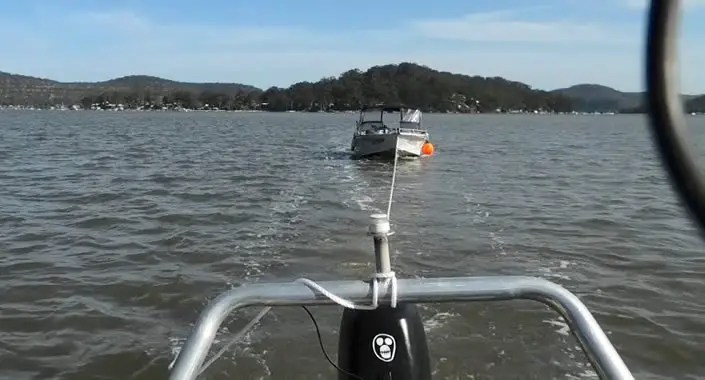
Quick and sudden bursts of speed will put unnecessary tension on the lines and the cleats.
It will also result in the towed boat being pulled towards the boat in front which will likely end in a collision.
Line tension should be keep taut
Try to keep a steady tension on the tow ropes and if you are towing in challenging waters or rough waves go slowly.
You will find it much more difficult to not only maintain a steady safe pace but you will also struggle to maintain constant line tension if you try to go too fast in challenging waters.
Having said that you will find times when the line slackens and then becomes taut again regardless of the water conditions.
This is normal but as I mentioned above you should try to avoid any sharp jolts due to sudden acceleration as you will put strain on the cleats are risk them being pulled out.
Try to tow upstream for extra safety
As best as you can attempt to tow upstream, or at the very least try to tow against the wind.
This will allow for the towing boat to have much more control.
Towing with the wind will cause the towed boat to be blown off course too easily.
If you find that you must tow with the wind or current then be aware that the towing boat will have to make constant adjustments as the towed vessel will be pushed from a steady straight course.
The towing boat will need to compensate for this.
How to approach the dock or ramp while towing a boat
The towing boat should try to pull the towed boat to the dock or ramp upstream even if this means traveling downstream for awhile in order to maneuver the boats into position.
As previously mentioned towing against the current and against the wind gives the towing boat more control.
Towing against the wind and current can also help to control speed when approaching the dock.
If all of these seems like it would be too stressful for you, when all you wanted was a fun day out on the water, then you can always call for professional assistance.

